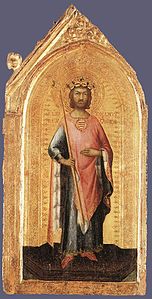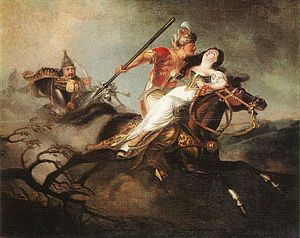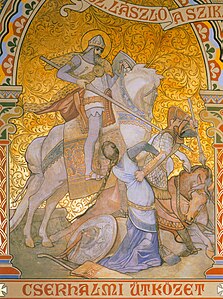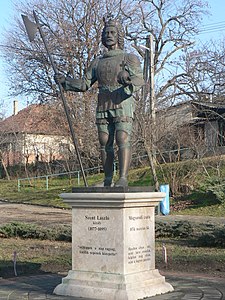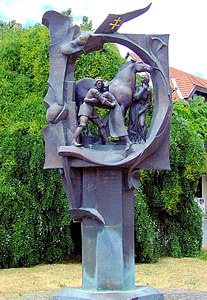Ladislaus I of Hungary
| Ladislaus I | |
|---|---|
 | |
| King of Hungary Contested bySolomonuntil 1081 | |
| Reign | 25 April 1077 – 29 July 1095 |
| Coronation | 1077,Székesfehérvár |
| Predecessor | Géza I |
| Successor | Coloman |
| King of Croatia Contested byPetar Snačić | |
| Reign | 1091 – 29 July 1095 |
| Predecessor | Stephen II |
| Successor | Petar Snačić |
| Regent | Álmosas Duke |
| Born | c.1040 Kraków,Kingdom of Poland |
| Died | 29 July 1095 (aged 54–55) Nyitra,Kingdom of Hungary (nowNitra,Slovakia) |
| Burial | Cathedral-Basilicaof Nagyvárad (todayOradea,Romania) |
| Spouse | Adelaide of Rheinfelden |
| Issue more... | Empress Irene of Byzantium |
| Dynasty | Árpád dynasty |
| Father | Béla I of Hungary |
| Mother | Richeza or Adelaide of Poland |
Ladislaus I(Hungarian:I. László,Croatian:Ladislav I.,Slovak:Ladislav I.,Polish:Władysław I;c.1040 – 29 July 1095), also known asSaint Ladislas,wasKing of Hungaryfrom 1077 andKing of Croatiafrom 1091. He was the second son of KingBéla I of HungaryandRicheza (or Adelaide) of Poland.After Béla's death in 1063, Ladislaus and his elder brother,Géza,acknowledged their cousinSolomonas the lawful king in exchange for receiving their father's formerduchy,which included one-third of the kingdom. They cooperated with Solomon for the next decade. Ladislaus'smost popular legend,which narrates his fight with a "Cuman" (aTurkicnomad marauder) who abducted a Hungarian girl, is connected to this period. The brothers' relationship with Solomon deteriorated in the early 1070s, and they rebelled against him. Géza was proclaimed king in 1074, but Solomon maintained control of the western regions of his kingdom. During Géza's reign, Ladislaus was his brother's most influential adviser.
Géza died in 1077, and his supporters made Ladislaus king. Solomon resisted Ladislaus with assistance from KingHenry IV of Germany.Ladislaus supported Henry IV's opponents during theInvestiture Controversy.In 1081, Solomon abdicated and acknowledged Ladislaus's reign, but he conspired to regain the royal crown, and Ladislaus imprisoned him. Ladislauscanonizedthe first Hungarian saints (including his distant relatives, KingStephen Iand DukeEmeric) in 1085. He set Solomon free during the canonization ceremony.
After aseries of civil wars,Ladislaus's main focus was the restoration of public safety. He introduced severe legislation, punishing those who violated property rights with death or mutilation. He occupied almost allCroatiain 1091, which marked the beginning of an expansion period for the medievalKingdom of Hungary.Ladislaus's victories over thePechenegsandCumansensured the security of his kingdom's eastern borders for about 150 years. His relationship with theHoly Seedeteriorated during the last years of his reign, as the popes claimed that Croatia was theirfief,but Ladislaus denied their claims.
Ladislaus was canonized on 27 June 1192 byPope Celestine III.Legends depict him as a pious knight-king, "the incarnation of the late-medieval Hungarian ideal of chivalry."[1]He is a popular saint in Hungary and neighboring nations, where many churches are dedicated to him.
Early years (before 1064)
[edit]Ladislaus was the second son of the future KingBéla I of Hungaryand his wife,Richeza (or Adelaide),who was a daughter of KingMieszko II Lambert of Poland.[2][3]Ladislaus and his elder brother,Géza,were born inPoland,where Béla had settled in the 1030s after beingbanished from Hungary.[4][5]Ladislaus was born around 1040.[4]Ladislaus's "physical and spiritual makeup testified to God's gracious will even at his birth", according to his late-12th-centuryLegend.[6]The almost contemporaneousGallus Anonymuswrote that Ladislaus was "raised from childhood in Poland" and almost became a "Polein his ways and life ".[5][7]He received aSlavicname: "Ladislaus" is derived from "Vladislav".[4]
Béla and his family returned to Hungary around 1048.[4]Béla received the so-called "Duchy"– which encompassed one-third of the kingdom – from his brother, KingAndrew I of Hungary.[8][9][10]TheIlluminated Chroniclementions that Andrew's son,Solomon,"wasanointedking with the consent of Duke Bela and his sons Geysa and Ladislaus "[11]in 1057 or 1058.[4]
Béla, who had been Andrew's heir before Solomon's coronation, left for Poland in 1059; his sons accompanied him.[4][12]They returned with Polish reinforcements and began a rebellion against Andrew.[8][13]After defeating Andrew, Béla was crowned king on 6 December 1060.[13]Solomon left the country, taking refuge in theHoly Roman Empire.[14][15]Béla I died on 11 September 1063, some time before German troopsentered Hungaryin order to restore Solomon.[12]Ladislaus and his brothers, Géza andLampert,went back to Poland, and Solomon was once again crowned king inSzékesfehérvár.[4][16]The three brothers returned when the Germans left Hungary.[17]To avoid another civil war, the brothers signed a treaty with Solomon on 20 January 1064,[17][18]acknowledging Solomon's reign in exchange for their father's duchy.[18][19]
Duke in Hungary (1064–1077)
[edit]Ladislaus and Géza probably divided the administration of their duchy; Ladislaus seems to have received the regions aroundBihar(now Biharia, Romania).[2][20][21]Géza and Ladislaus cooperated with King Solomon between 1064 and 1071.[21]The most popular story in Ladislaus's later legends – his fight with a "Cuman"warrior who abducted a Christian maiden – occurred during this period.[22][23]The relationship between the king and his cousins became tense in the early 1070s.[24]When Géza accompanied Solomon on a military campaign against theByzantine Empirein 1072, Ladislaus stayed behind with half of the ducal troops inNyírségto "avenge his brother with a strong hand"[25]if Solomon harmed Géza.[24][26]

Realizing that another civil war was inevitable, the king and dukes launched negotiations to obtain the assistance of foreign powers.[24][26]First, Ladislaus visited theKievan Rus',but he returned without reinforcements.[2][26]He then went toMoravia,and persuaded DukeOtto I of Olomoucto accompany him back to Hungary withCzechtroops.[2][27]By the time they returned to Hungary, the royal army had already invaded the duchy and routed Géza's troops at theBattle of Kemejon 26 February 1074.[24][28][29]Ladislaus met his fleeing brother atVác,and they decided to continue the fight against Solomon.[28]A legend preserved in theIlluminated Chroniclementions that before the battle, Ladislaus "saw in broad daylight avision from heaven"of an angel placing a crown on Géza's head.[30][31]Another legendary episode also predicted the dukes' triumph over the king: an "ermineof purest white "jumped from a thorny bush to Ladislaus's lance and then onto his chest.[30][32]The decisiveBattle of Mogyoródwas fought on 14 March 1074.[28][29]Ladislaus commanded "the troops fromByhor"on the left flank.[28][33]Solomon was defeated,[29]but instead of surrendering to his cousins, he fled to the western borders of the kingdom to seek assistance from his brother-in-lawHenry IV of Germany.[34]
Géza was proclaimed king, but Solomon established himself inMosonandPressburg(nowBratislava, Slovakia).[28][34]During his brother's reign, Ladislaus administered all of their father's former duchy.[27]He repelled Solomon's attack onNyitra(present-dayNitra, Slovakia) in August or September 1074, but he could not seize Pressburg.[27]Ladislaus was also his brother's main advisor.[27]Legend says that Géza decided to build a church dedicated to theHoly VirgininVácafter Ladislaus explained the significance of the wondrous appearance of ared deerat the place where the church would be erected:[35]
As [King Géza and Duke Ladislaus] were standing at a spot near [Vác], where is now the church of theblessed apostle Peter,a stag appeared to them with many candles burning upon his horns, and it began to run swifly before them towards the wood, and at the spot where is now the monastery, it halted and stood still. When the soldiers shot their arrows at it, it leapt into theDanube,and they saw it no more. At this sight the blessed Ladislaus said: "Truly that was no stag, but anangelfrom God. "And King [Géza] said:" Tell me, beloved brother, what may all the candles signify which we saw burning on the stag's horns. "The blessed Ladislaus answered:" They are not horns, but wings; they are not burning candles, but shining feathers. It has shown to us that we are to build the church of the Blessed Virgin on the place where it planted its feet, and not elsewhere. "
His reign
[edit]Consolidation (1077–1085)
[edit]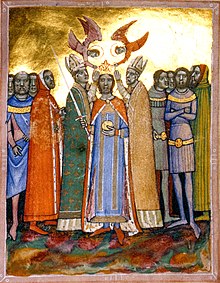
Géza I died on 25 April 1077.[37]Since Géza's sons,ColomanandÁlmos,wereminors,his supporters proclaimed Ladislaus king instead.[27]Gallus Anonymus emphasizes that KingBoleslaus II the Boldof Poland "drove out" Solomon "from Hungary with his forces, and placed [Ladislaus] on the throne"; Boleslaus even called Ladislaus "his king".[5][38][39]Although theIlluminated Chronicleemphasizes that Ladislaus "never placed the crown upon his head, for he desired a heavenly crown rather than the earthly crown of a mortal king", all his coins depict him wearing a crown, suggesting that Ladislaus was actually crowned around 1078.[40][41][42]Shortly after his coronation, Ladislaus promulgated two law books, which incorporated the decisions of an assembly of the "magnates of the kingdom", held inPannonhalma.[19][43]The majority of these laws were draconian measures to defend private property, showing that Ladislaus primarily focused on internal consolidation and security during the first years of his reign.[44][45]Those who were caughtstealingwere to be executed, and even criminals who committed minor offenses against property rights were blinded or sold as slaves.[44]His other laws regulated legal proceedings and economic matters, including the issuing ofjudicial summonsand theroyal monopolyon salt trade.[19][44]
If someone, freeman or bondman, should be caught in theft, he shall behanged.But if heflees to the churchto evade thegallows,he shall be led out of the church and blinded. A bondman caught in theft, if he does not flee to the church, shall be hanged; the owner of the stolen goods shall take a loss in the lost goods. The sons and daughters of a freeman caught in theft who fled to the church, was led out and blinded, if they are ten years old or less, shall retain their freedom; but if they are older than ten years they shall be reduced to servitude and lose all their property. A bondman or freeman who steals a goose or a hen shall lose one eye and shall restore what he has stolen.
— Laws of King Ladislas I[46]

TheIlluminated Chronicleclaims that Ladislaus planned to "restore the kingdom" to Solomon and "himself have the dukedom",[41][42][40]but almost all contemporaneous sources contradict this report.[47]Ladislaus approachedPope Gregory VII,who was the primary opponent of Solomon's ally, Henry IV of Germany.[47]At the Pope's request, Ladislaus shelteredBavariannobles who had rebelled against Henry.[48][49]In 1078 or 1079, Ladislaus marriedAdelaide,a daughter ofRudolf of Rheinfelden,whomthe German princes had electedto take the place of Henry IV as king.[48][49][50]Ladislaus supportedLeopold II, Margrave of Austria,who also rebelled against Henry IV; however, the German monarch forced Leopold to surrender in May 1078.[51]
Taking advantage of the internal conflicts in the Holy Roman Empire, Ladislaus besieged and captured the fortress of Moson from Solomon in early 1079.[50][52]However, Henry IV stormed the western regions of Hungary, and secured Solomon's position.[52]The German invasion also prevented Ladislaus from assisting Boleslaus the Bold, who fled to Hungary after his subjects expelled him from Poland.[53]Ladislaus initiated negotiations with Solomon, who abdicated in 1080 or 1081 in exchange for "revenues sufficient to bear the expenses of a king".[45][50][52][54]However, Solomon soon began conspiring against Ladislaus, and Ladislaus imprisoned him.[42][52]
The first five Hungarian saints, including the first king of Hungary,Stephen I,and Stephen's son,Emeric,werecanonizedduring Ladislaus's reign.[52]Stephen's canonization demonstrates Ladislaus's magnanimity, because Ladislaus's grandfather,Vazul,had been blinded on Stephen's orders in the 1030s.[45][55]Historian László Kontler says that the canonization ceremony, held in August 1083, was also a political act, demonstrating Ladislaus's "commitment to preserving and strengthening" the Christian state.[56]Ladislaus even dedicated a newly establishedBenedictinemonastery – Szentjobb Abbey – to Stephen's right arm, known as the "Holy Dexter",which was miraculously found intact.[45]Ladislaus released Solomon at the time of the ceremony;[45]legend said that Stephen's grave could not be opened until he did so.[48]
[The] Lord, in order to show how merciful [King Stephen I] had been while living in a mortal body, demonstrated his approval of [Stephen's revelation as a saint] before all other works when [the king] was already reigning with Christ to the point that though for three days they struggled with all their might to raise his holy body, it was not by any means to be moved from its place. For in that time, because of the sins, a grave discord arose between the said king Ladislas and his cousin Solomon, because of which, Solomon, captured, was held in prison. Therefore when they tried in vain to raise the body, a certainrecluseat the church of the Holy Savior in Bökénysomlyó, by the name of Karitas, whose famous life at the time was held in esteem, confided to the king by a revelation made to her from heaven that they exerted themselves in vain; it would be impossible to transfer the relics of the holy king until unconditional pardon was offered to Solomon, setting him free from the confinement of prison. And thus, bringing him forth from the prison, and repeating the three-day fast, when the third day arrived for the transferal of the holy remains, the stone lying over the grave was lifted up with such ease as if it had been of no weight before.
After his release, Solomon made a final effort to regain his crown.[45][58]He persuaded aPechenegchieftain, Kutesk, to invade Hungary in 1085.[58]Ladislaus defeated the invaders at the upper courses of theTisza River.[58][59]
Expansion (1085–1092)
[edit]In August 1087, German princes who opposed Henry IV's rule held a conference inSpeyer.[58][60]The contemporaneousBernold of St Blasienmentions that Ladislaus sent envoys to the meeting, and "promised that he would assist [them] with 20,000 knights, if it became necessary".[61][62]Ladislaus also recognizedPope Victor IIIas the legitimate pope, rather thanClement III,who had been elected pope at Henry IV's initiative.[62]However, Ladislaus provided no further support to Henry IV's opponents after he was informed of Solomon's death in 1087.[63]

KingDemetrius Zvonimir of Croatia's wife,Helen,was Ladislaus's sister.[64]After the death of Zvonimir and his successor,Stephen II,a conflict developed between factions ofCroatian noblemen.[64][65][66]

At Helen's request, Ladislaus intervened in the conflict and invaded Croatia in 1091.[67]The same year, he wrote toOderizius,Abbot of Monte Cassinoin Italy, about his invasion.[66][65]Thomas the Archdeacon's chronicle describes how Ladislaus "occupied the entire land from theRiver Dravato the mountains called the Iron Alps without encountering opposition ".[68][69][70]However, his opponents crowned a local nobleman,Petar Snačić,as king.[71]Snačić fought in theGvozd Mountains,preventing the complete conquest of Croatia.[65]Ladislaus appointed his nephew, Álmos, to administer the occupied territory.[71][65]Around the same time, Ladislaus set up aseparate diocese in Slavonia,with its see inZagreb.[71]The bishop of the new see became thesuffraganto thearchbishop of Esztergomin Hungary.[65]
Ladislaus admitted in his letter to Oderizius that he could not "promote the cause of earthly dignities without committing grave sins".[72]HistorianBálint Hómansays that Ladislaus was referring to a developing conflict withPope Urban II,who objected to Ladislaus's refusal to acknowledge the Holy See's suzerainty over Croatia.[72][73][74][75]In the letter, Ladislaus styled himself as "king of the Hungarians and of Messia".[63][76][77]Historian Ferenc Makk writes that the latter title referred toMoesia,implying that Ladislaus had taken the regions between theGreat MoravaandDrinarivers from the Byzantine Empire.[63]No other documents refer to Ladislaus's occupation of Moesia, suggesting that if Ladislaus did occupy the region, he lost it quickly.[76]Alexandru Madgearu says that "Messia" should rather be associated with Bosnia, which was occupied during Ladislaus's campaign against Croatia.[77]
TheCumansinvaded and plundered the eastern part of the kingdom in 1091.[63]The invading Cumans were leading by chieftain Kapolcs, they broke first inTransylvania,then the territory between theDanubeandTiszarivers. The Cumans tried to leave Hungary with their huge booty and prisoners, but King Ladislaus reached and defeated them near theTemesriver. Ladislaus offered theChristianityfor the Cuman survivors, the majority of them accepted, thus the king settled them inJászság.The rumor of the losing battle reached the Cuman camp, the Cumans threatened King Ladislaus with revenge and demanded to free the Cuman prisoners. King Ladislaus marched to the Hungarian border to prevent the next invasion. The two armies clashed nearSeverin,the Hungarian army was victorious, King Ladislaus killed Ákos, the Cuman chieftain.[78]Makk argues that theByzantinespersuaded them to attack Hungary,[79]while theIlluminated Chroniclestates that the Cumans were incited by the "Ruthenians".[80][81][82]In retaliation, the chronicle continues, Ladislaus invaded the neighboringRus' principalities,forcing the "Ruthenians" to ask "for mercy" and to promise "that they would be faithful to him in all things".[80][83]No Rus' chronicle documents Ladislaus's military action.[84]
Bernold of St Blasien writes that DukeWelf of Bavariaprevented a conference that Emperor Henry IV "had arranged with the king of the Hungarians" in December 1092.[72][85]A letter written by Henry refers to "the alliance into which [he] once entered" with Ladislaus.[81][86]Pope Urban II also mentioned that the Hungarians "left the shepherds of their salvation", implying that Ladislaus had changed sides and acknowledged the legitimacy ofAntipopeClement III.[87][88]In the deed of the BenedictineSomogyvár Abbey,Ladislaus stated that the abbot should be obedient to him, proving that Ladislaus opposed the Church's independence, which was demanded by theGregorian Reforms.[89]Ladislaus personally presided overan assembly of the Hungarian prelatesthat met inSzabolcson 21 May 1091.[90]The synod recognized the legitimacy of a clergyman's first marriage, in contrast to therequirements of canon law,which states that members of the clergy may not marry at all.[91]According to a scholarly theory, the sees of the dioceses ofKalocsaandBiharwere moved toBács(now Bač,Serbia) andNagyvárad(present-day Oradea, Romania), respectively, during Ladislaus's reign.[92][93]
Last years (1092–1095)
[edit]
Ladislaus intervened in a conflict betweenWładysław I Herman,Duke of Poland,and the duke's illegitimate son,Zbigniew,on the latter's behalf.[94]He marched to Poland and captured Herman's younger son,Boleslaus,in 1093.[94]At Ladislaus's demand, Władysław I Herman declared Zbigniew his legitimate son.[95]TheIlluminated Chroniclealso mentions that the Hungarian troops capturedKrakówduring Ladislaus's campaign, but the credibility of this report has been questioned.[79]
TheIlluminated Chroniclestates that "messengers fromFranceand fromSpain,fromEnglandandBritain,and especially from Willermus, the brother of the King of the Franks "visited Ladislaus in Bodrog (near present-dayBački Monoštorin Serbia) on Easter 1095, asking him to lead theircrusadeto theHoly Land.[96][97]Ladislaus's legend says that he decided "to go toJerusalem,and to die there for Christ ".[98]The whole story was invented, probably during the reign of KingBéla III of Hungary(who was actually planning to lead a crusade to the Holy Land in the 1190s), according to historian Gábor Klaniczay.[99]However, Ladislaus did plan to invade Bohemia, because he wanted to assisthis sister's sons,SvatoplukandOtto.[81]He became seriously ill before reaching Moravia.[81][100]TheIlluminated Chroniclenarrates that Ladislaus, who had no sons, "called together his chief men", telling them that his brother's younger son, Álmos, "should reign after him".[81][100][101]
Ladislaus died near the Hungarian-Bohemian border on 29 July 1095.[81]Apapal bullofPope Paschal IIin 1106 states that Ladislaus's "venerable body rests" in Somogyvár Abbey, implying that Ladislaus had been buried inSomogyvár.[102]On the other hand, Ladislaus's late 12th-century "Legend" provides that his attendants buried him inSzékesfehérvár,but the cart carrying his body "set out toVáradon its own, unassisted by any draft animal ".[102]
Family
[edit]| Ancestors of Ladislaus I of Hungary[103][104][105] | ||||||||||||||||||||||||||||||||||||||||||||||||||||||||||||||||||||||||||||||||||||||||||||||||||||||||||||||||||||||||||||||||||||||||||||||||||||||||||||||||||||||||||||||||||||||||||||||||||||||||||||||||||||||||||||||||||||||||||||||||||||||||||||||||||||||||||||||||||||||||||||||||||||||||||||||||||||||||||||||||||||||||||||||||||||||||||||||||||||||||||||||||||||||||||||||||||||||||||||||||||||||||||||||||||||||||||||||||||||||||||||||||||||||||||||||||||||||||||||||||||||||||||||||||||||||||||||||||||||||||||||||||||||||||||||||||||||||||||||||||||||||||||||||||||||||||||||||||
|---|---|---|---|---|---|---|---|---|---|---|---|---|---|---|---|---|---|---|---|---|---|---|---|---|---|---|---|---|---|---|---|---|---|---|---|---|---|---|---|---|---|---|---|---|---|---|---|---|---|---|---|---|---|---|---|---|---|---|---|---|---|---|---|---|---|---|---|---|---|---|---|---|---|---|---|---|---|---|---|---|---|---|---|---|---|---|---|---|---|---|---|---|---|---|---|---|---|---|---|---|---|---|---|---|---|---|---|---|---|---|---|---|---|---|---|---|---|---|---|---|---|---|---|---|---|---|---|---|---|---|---|---|---|---|---|---|---|---|---|---|---|---|---|---|---|---|---|---|---|---|---|---|---|---|---|---|---|---|---|---|---|---|---|---|---|---|---|---|---|---|---|---|---|---|---|---|---|---|---|---|---|---|---|---|---|---|---|---|---|---|---|---|---|---|---|---|---|---|---|---|---|---|---|---|---|---|---|---|---|---|---|---|---|---|---|---|---|---|---|---|---|---|---|---|---|---|---|---|---|---|---|---|---|---|---|---|---|---|---|---|---|---|---|---|---|---|---|---|---|---|---|---|---|---|---|---|---|---|---|---|---|---|---|---|---|---|---|---|---|---|---|---|---|---|---|---|---|---|---|---|---|---|---|---|---|---|---|---|---|---|---|---|---|---|---|---|---|---|---|---|---|---|---|---|---|---|---|---|---|---|---|---|---|---|---|---|---|---|---|---|---|---|---|---|---|---|---|---|---|---|---|---|---|---|---|---|---|---|---|---|---|---|---|---|---|---|---|---|---|---|---|---|---|---|---|---|---|---|---|---|---|---|---|---|---|---|---|---|---|---|---|---|---|---|---|---|---|---|---|---|---|---|---|---|---|---|---|---|---|---|---|---|---|---|---|---|---|---|---|---|---|---|---|---|---|---|---|---|---|---|---|---|---|---|---|---|---|---|---|---|---|---|---|---|---|---|---|---|---|---|---|---|---|---|---|---|---|---|---|---|---|---|---|---|---|---|---|---|---|---|---|---|---|---|---|---|---|---|---|---|---|---|---|---|---|---|---|---|---|---|---|---|---|---|---|---|---|---|---|---|---|---|---|---|---|---|---|---|---|---|---|---|---|---|---|---|---|---|---|---|---|---|---|---|---|---|---|---|---|---|---|---|---|---|---|---|---|---|---|---|---|---|---|---|---|---|---|---|---|---|---|---|---|---|---|---|---|---|---|---|---|---|---|---|---|---|---|---|---|---|---|---|---|---|---|---|---|---|---|---|---|---|---|---|---|---|---|---|---|---|---|---|---|---|---|---|---|---|---|---|---|---|---|---|---|---|---|---|---|---|---|---|
| ||||||||||||||||||||||||||||||||||||||||||||||||||||||||||||||||||||||||||||||||||||||||||||||||||||||||||||||||||||||||||||||||||||||||||||||||||||||||||||||||||||||||||||||||||||||||||||||||||||||||||||||||||||||||||||||||||||||||||||||||||||||||||||||||||||||||||||||||||||||||||||||||||||||||||||||||||||||||||||||||||||||||||||||||||||||||||||||||||||||||||||||||||||||||||||||||||||||||||||||||||||||||||||||||||||||||||||||||||||||||||||||||||||||||||||||||||||||||||||||||||||||||||||||||||||||||||||||||||||||||||||||||||||||||||||||||||||||||||||||||||||||||||||||||||||||||||||||||
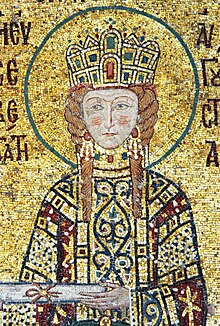
Historian Gyula Kristó says that Ladislaus had a first wife,[49]but her name and family are not known.[49]She gave birth to a daughter, whose name is also unknown.[49]Ladislaus's daughter married PrinceIaroslav Sviatopolchich of Volhiniaaround 1090.[49]Ladislaus married again in 1078, toAdelaide,a daughter of the Germananti-kingRudolf of Swabia.[49]Their only known child,Piroska,became the wife of theByzantine EmperorJohn II Komnenosin 1105 or 1106.[106]
Ladislaus's family and relatives who are mentioned in the article are shown in the following family tree.[107]
| a lady of the Tátony clan | Vazul | ||||||||||||||||||||||||||||||||||||||||||||||||||||||||||||
| Andrew I | Béla I | Richeza or Adelaide | |||||||||||||||||||||||||||||||||||||||||||||||||||||||||||
| Solomon | |||||||||||||||||||||||||||||||||||||||||||||||||||||||||||||
| Géza I | unknown* | Ladislaus | Adelaide of Rheinfelden | Lampert | Helena | Zvonimir of Croatia | |||||||||||||||||||||||||||||||||||||||||||||||||||||||
| Kings of Hungary (from 1095) | Iaroslav of Volhinia | daughter | Irene (born Piroska) | John II Komnenos | |||||||||||||||||||||||||||||||||||||||||||||||||||||||||
*According to a scholarly theory suggesting that Ladislaus had two wives.
Legacy
[edit]
Consolidation of the Christian monarchy
[edit]For centuries, hagiographers and historians have emphasized Ladislaus's prominent role in the consolidation of the Christian monarchy.[108]The chronicles also stressed hisidoneitas,or personal suitability, to reign, because the legitimacy of his rule was questionable.[108]TheIlluminated Chronicleclearly states that Ladislaus knew that "the right of law between him and [Solomon] was not on his side but only the force of fact".[54][108]
After Ladislaus's victories over the Pechenegs and the Cumans, the nomadic peoples of the Pontic steppes stopped invading Hungary until the Mongol invasion of 1241.[109]Kristó suggests that theSzékely people—a community of Hungarian-speaking warriors—started settling the easternmost borderlands under Ladislaus.[59][110]The "historic association of the Kingdom of Hungary andCroatia",which ended in 1918, began with Ladislaus's conquest of Croatia.[55]His conquest marked the beginning of a period of Hungarian expansion, which ensured that Hungary developed into a leadingCentral Europeanpower during the following centuries.[109]It became a customary rite for a newly crowned Hungarian king to make a pilgrimage to Ladislaus's shrine atVárad.[37]Louis I of Hungary,who made many attempts to expand his territory in the Balkan Peninsula, showed a special respect for Ladislaus.[111]
Hungary had never had as great as king, so they repute
And the land thereafter never bore that much and splendid fruit.
Veneration
[edit]St. Ladislaus | |
|---|---|
 Saint Ladislaus's reliquary of the late 19th-century (in the Cathedral-Basilica of Oradea, Romania) | |
| King and Confessor | |
| Venerated in | Roman Catholic Church |
| Canonized | 27 June 1192 (dubious) byPope Celestine III(dubious) |
| Majorshrine | Cathedral-Basilica ofOradea,Romaniaand Cathedral-Basilica ofGyőr,Hungary |
| Feast | 27 June |
| Attributes | Holy Crown of St. Stephen I Long sword Two angels Banner |
| Patronage | Patron Saint ofHungary Patron Saint of theSzékelys Protector against pestilence |
Gábor Klaniczay emphasizes that Ladislaus "seemed expressly designed to personify the knight-king ideal" of his age.[108]During the reign of Ladislaus's successor,Coloman the Learned,BishopHartviksaid that Ladislaus's "character was distinguished by the respectability of morals and remarkable for the splendor of his virtues".[81][112]The so-calledGesta Ladislai regis( "The Deeds of King Ladislaus" ), which are the texts about Ladislaus's life and reign preserved in 14th-century Hungarian chronicles, were written during Coloman's rule.[108]Five significant events of Ladislaus's life, which were not included in his official legend, were only preserved in theGesta.[22]
The most popular story describes Ladislaus's fight with a "Cuman"warrior after theBattle of Kerlés(at present-dayChiraleș,Romania) in 1068.[113][114]In the battle, the united armies of Solomon, Géza and Ladislaus routed a band ofPechenegsorOghuz Turkswho were plundering the eastern parts of the kingdom.[4][115]According to the version recorded in theIlluminated Chronicle,Ladislaus spotted a pagan warrior fleeing from the battlefield with a captive Hungarian maiden.[114]Ladislaus pursued the "Cuman", but he could not stop him.[116]On Ladislaus's advice, the maiden pulled the warrior off his horse, allowing Ladislaus to kill the "Cuman" after a long fight on the ground.[116][117]ArchaeologistGyula Lászlósays that murals depicting this legend in medieval churches preserved the elements of pagan myths, including a "struggle between forces of light and darkness".[114][118]
[The] most blessed Duke Ladislaus saw one of the pagans who was carrying off on his horse a beautiful Hungarian girl. The saintly Duke Ladislaus thought that it was the daughter of theBishop of Warad,and although he was seriously wounded, he swiftly pursued him on his horse, which he called by the name of Zug. When he caught up with him and wished to spear him, he could not do so, for neither could his own horse go any faster nor did the other's horse yield any ground, but there remained the distance of a man's arm between his spear and the Coman's back. So the saintly Duke Ladislaus shouted to the girl and said: "Fair sister, take hold of the Coman by his belt and throw yourself to the ground." Which she did; and the saintly Duke Ladislaus was about to spear him as he lay upon the ground, for he wished to kill him. But the girl strongly pleaded with him not to kill him, but to let him go. Whence it is to be seen that there is no faith in women; for it was probably because of strong carnal love that she wished him to go free. But after having fought for a long time with him and unmanned him, the saintly Duke killed him. But the girl was not the bishop's daughter.
During the reign ofStephen II of Hungary,Ladislaus's shrine in the cathedral of Várad became a preferred venue fortrials by ordeal.[120]However, it cannot be determined whether Ladislaus became subject to veneration soon after his death, or if his cult emerged after he was canonized byBéla III of Hungaryon 27 June 1192.[121]Béla had lived in theByzantinecourt, where Ladislaus's daughter, Irene, was venerated as a saint.[122]
According to Thomas the Archdeacon,Pope Innocent IIIdeclared that Ladislaus "should be enrolled in the catalogue of saints", but his report is unreliable, becauseCelestine IIIwas pope at the time.[123][124]Celestine III's bulls and charters make no reference to Ladislaus's canonization, implying that Ladislaus was canonized without the Holy See's authorization.[125]The nearly contemporaneousRegestrum Varadinensesays that abondsman,named "Tekus, son of the craftsman Dénes", opened Ladislaus's tomb at the beginning of the ceremony, after which Tekus was granted freedom.[98]Parts of Ladislaus's head and right hand were severed so that they could be distributed as relics.[98]The 15th-century silverreliquarythat contains Ladislaus's head is displayed in theGyőr Cathedral.[126]

Ladislaus's official legend, which was compiled after 1204,[98]attributes a number ofmiraclesto him.[127]According to one of his legends, a pestilence spread throughout the kingdom during Ladislaus's reign. Ladislaus prayed for a cure; he then shot an arrow into the air at random, hitting a herb which cured the illness.[127]This plant became known as "Saint Ladislaus's herb"in Hungary.[127]
Ladislaus is apatron saintof Hungary, especially along the borders.[127][128]In particular, soldiers and theSzékely peoplevenerate him.[120]A late medieval legend says that Ladislaus appeared at the head of a Székely army fighting against and routing a plundering band of Tatars in 1345.[120]He is also called upon during times of pestilence.[127]He is often depicted as a mature, bearded man wearing a royal crown and holding a long sword orbanner.[127]He is also shown on his knees before a deer, or in the company of two angels.[127]
KingSigismund of Hungarydied on 1437, and as ordered in life, he was buried at Várad (nowOradea), next to the tomb of the King Saint Ladislaus, who was the ideal of the perfect monarch, warrior and Christian for that time and was deeply venerated by Sigismund.[129]
Herma of King Saint Ladislaus and Genetics
[edit]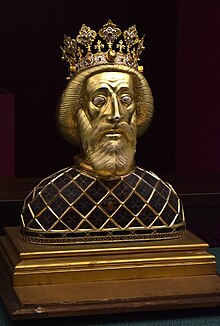
The skullrelicin the Saint Ladislaus’ Herma preserved in theCathedral Basilica of Győr,is one of the most important relics for Hungarians.[130]
King Saint Ladislaus of Hungary completed the work of KingSaint Stephen of Hungary,he consolidated the Hungarian state power and strengthened theChristianity.His charismatic personality, strategic leadership and military talents resulted the termination of internal power struggles and foreign military threats. He was seen as the embodiment of the knight-king ideal to be emulated all over Europe. He was canonized in 1192 at the request of KingBéla III of Hungary,and his body was exhumed to prepare relics from his skull and other skeletal remains as was the custom in that medieval times.[130]
According to historian György Szabados,Gyula Lászlóproved already in 1965 that the face of the Saint Ladislaus’ Herma depicts King Béla III. The skull reconstruction of theRoyal Basilica's tombfind in Székesfehérvár also shows the face of the Herma, which is not surprising, because King Ladislaus had already been dead for 97 years in 1192, so only the then living king from the same family, Béla III was worthy to sit as a model for the creation of the face of the Herma.[131]
The wooden herm containing the skull was damaged in a fire in 1406, but miraculously the skull has been preserved unharmed. Later it was placed into the current Herma created during the reign of KingSigismund of Hungary.In the 16th century, the relic had to be rescued fromVáraddue to the ravage of Transylvania by the protestants. In the first decades of the 17th century, it reached its current location in the Cathedral ofGyőrafter passing throughPrague,Pozsony (nowBratislava) andVeszprém.[130]
The turbulent history events of the Herma raised doubts concerning the authenticity of the relic by historians and archaeologists.[130]At that time, the onlyÁrpád dynastyking, the remains of KingBéla IIIhad known and identified, because little earlier, the Institute of Hungarian Research determinated the whole genome data of King Béla III which was published in 2020.[132]Thus the Hungarian scholars were able to compare the paternal Y chromosome sequence of the skull to that of King Béla III from whom a whole genome data was available.[130]
On 4 June 2021, Endre Neparáczki collected a sample from the skull of the herm, during his researches so far, they isolated from the sample one of the best own extracted endogenous DNA.[133]The Institute of Hungarian Research defined the genetic composition of the skull found in the herm and it was published in 2023. The result supported the originality of Saint Ladislaus relic, theY chromosomeof the skull belongs to the exclusive haplogroup of the Árpád-dynasty R-ARP (R1a1a1b2a2a1c3a3b) and the kinship analysis detected the skull is at five generations distance from King Béla III.[130][133]
The R-ARP sub-haplogroup belongs to the R-Z2123 clade, thephylogeneticanalysis suggested aBronze AgeBMACorigin of the R-Z2123 sub-haplogroup which belongs to the R-Z2125 clade, which was detected in individuals from the Middle-LateBronze Ageon the Caspian Steppe, connected to thePotapovka,SintashtaandAndronovocultures. In theIron Age,this haplogroup was detected in the Turan basin and inScytho-Siberiansof theMinusinsk Basin,later among theAsian Huns(Xiongnus) and up until theMiddle AgesinMongoliawhich indicates an eastward and southward spread of the haplogroup. The first appearance of R-Z2125 in theCarpathian Basinwas detected in 5th-centuryEuropean Huns,and 7th–8th-centuryAvars,but it also arrived with theconquering Hungarians,in the 9th–10th century includingÁrpádand his family.[130]The basic premise of the Hungarian medieval chronicle tradition (for example in theChronicon Pictum) that the Huns, i.e. theHungarianscoming out twice fromScythia,the guiding principle was the Hun-Hungarian continuity.[134]The genomic analyses of theHungarian royalÁrpád familymembers are in line with the reported conquering Hungarian-Hun origin of the dynasty in harmony with their Y-chromosomal phylogenetic connections.[130]
The Institute of Hungarian Research published a genetic study in 2022 in which 113 Hungarian conqueror samples were analized.[135]The result of the genome analysis of King Saint Ladislaus confirmed that the Árpád dynasty originated from the same ethnic group as other members of the Hungarian conqueror elite, and he had higher genetic affinity to the Hungarian conquerors than the analyzed later Hungarian royal members. King Saint Ladislaus had more Eastern genomic heritage than his later relatives, on the PCA genetic map he shifted slightly eastward from the cloud of modern European populations, while the genome of King Béla III was projected near modern Hungarians and Croatians, because the Central Asian genomes were progressively attenuated during the centuries through dynastic marriages with European royal families.[130][133]
Saint Ladislaus became the first saint in the world whose identity was confirmed by archaeogenetic tests.[133]
Gallery
[edit]-
Saint Ladislaus (painting bySimone Martini,1326) (Museo Civico di Santa Maria della Consolazione,Altomonte,Italy)
-
1. Burial of Saint Ladislaus. 2. Persons praying at his tomb. 3. A rich man unable to lift a silver tray from his tomb. 4. A poor man lifting the silver tray. (Anjou Legendarium,14th century)
-
In the initial "P", Prince Ladislaus is fighting a duel with a Cuman warrior (Chronicon Pictum,1358)
-
Saint Ladislaus chases the Cuman warrior who kidnapped a girl (Chronica Hungarorum,1488)
-
Saint Ladislaus the knight-king (Chronica Hungarorum,1488)
-
King Saint Ladislaus (Nádasdy Mausoleum,1664)
-
Saint Ladislaus atBattle of Cserhalom(painting byKároly Kisfaludy,1826–1830) (Hungarian National Gallery,Budapest)
-
The depiction of theBattle of Cserhalomin the Saint Ladislaus chapel,Matthias Church(Budapest,Hungary) (painting byKároly Lotz,19th century). King Saint Ladislaus of Hungary saves the kidnapped Hungarian girl from a Cuman warrior.
-
Saint Ladislaus in the Saint Stephen room in theBuda Castle
-
Statue of Saint Ladislaus at theHeroes' Square,Budapest
-
Statue of Saint Ladislaus made to memory of theBattle of MogyoródinMogyoród,Hungary(made by Lajos Józsa in 2001)
-
Statue of Saint Ladislaus inSzekszárd,Hungary(made by Benedek Nagy in 2001). The composition was based onthe Ladislaus and Cuman warrior duel scene in the initial "P"in theChronicon Pictum.
-
Horse statue of Saint Ladislaus in theRoman Catholic Diocese of Oradea,Romania(made by Árpád Deák in 2023)
See also
[edit]References
[edit]- ^Klaniczay 2002,p. 187.
- ^abcdMakk 1994,p. 394.
- ^Kristó & Makk 1996,pp. 78, 107.
- ^abcdefghKristó & Makk 1996,p. 107.
- ^abcBárány 2012,p. 338.
- ^Klaniczay 2002,p. 174.
- ^abThe Deeds of the Princes of the Poles(ch. 27.), p. 97.
- ^abKontler 1999,p. 60.
- ^Engel 2001,p. 30.
- ^Kristó & Makk 1996,p. 79.
- ^The Hungarian Illuminated Chronicle(ch. 65.92), p. 115.
- ^abÉrszegi & Solymosi 1981,p. 88.
- ^abEngel 2001,p. 31.
- ^Kontler 1999,p. 61.
- ^Robinson 1999,p. 53.
- ^Érszegi & Solymosi 1981,pp. 88–89.
- ^abBartl et al. 2002,pp. 26–27.
- ^abÉrszegi & Solymosi 1981,p. 89.
- ^abcBartl et al. 2002,p. 27.
- ^Steinhübel 2011,p. 27.
- ^abKristó & Makk 1996,p. 106.
- ^abKlaniczay 2002,pp. 176–177.
- ^Kristó & Makk 1996,pp. 107–108.
- ^abcdKristó & Makk 1996,p. 109.
- ^The Hungarian Illuminated Chronicle(ch. 79.111), p. 119.
- ^abcKosztolnyik 1981,p. 85.
- ^abcdeKristó & Makk 1996,p. 110.
- ^abcdeSteinhübel 2011,p. 28.
- ^abcÉrszegi & Solymosi 1981,p. 90.
- ^abKlaniczay 2002,p. 177.
- ^The Hungarian Illuminated Chronicle(ch. 83.120), p. 123.
- ^The Hungarian Illuminated Chronicle(ch. 85.121), p. 124.
- ^The Hungarian Illuminated Chronicle(ch. 84.121), p. 124.
- ^abKristó & Makk 1996,p. 94.
- ^Klaniczay 2002,pp. 177–178.
- ^The Hungarian Illuminated Chronicle(ch. 87–88.124), p. 125.
- ^abEngel 2001,p. 32.
- ^The Deeds of the Princes of the Poles(ch. 27–28.), pp. 97–99.
- ^Manteuffel 1982,p. 97.
- ^abKristó & Makk 1996,p. 114.
- ^abThe Hungarian Illuminated Chronicle(ch. 93.131), p. 127.
- ^abcKosztolnyik 1981,p. 93.
- ^Laws of King Ladislas I(Ladislas II:Preamble), p. 12.
- ^abcKontler 1999,p. 62.
- ^abcdefEngel 2001,p. 33.
- ^Laws of King Ladislas I(Ladislas II:12), pp. 14–16.
- ^abKristó & Makk 1996,pp. 117–118.
- ^abcKosztolnyik 1981,p. 94.
- ^abcdefgKristó & Makk 1996,p. 118.
- ^abcÉrszegi & Solymosi 1981,p. 92.
- ^Robinson 1999,p. 191.
- ^abcdeKristó & Makk 1996,p. 119.
- ^Manteuffel 1982,p. 98.
- ^abThe Hungarian Illuminated Chronicle(ch. 94.133), p. 128.
- ^abKontler 1999,p. 63.
- ^Kontler 1999,p. 64.
- ^Hartvic, Life of King Stephen of Hungary(ch. 24.), p. 393.
- ^abcdÉrszegi & Solymosi 1981,p. 93.
- ^abKristó & Makk 1996,p. 121.
- ^Robinson 1999,p. 263.
- ^Bernold of St Blasien, Chronicle(year 1087), p. 290.
- ^abKosztolnyik 1981,p. 100.
- ^abcdKristó & Makk 1996,p. 120.
- ^abFine 1991,p. 283.
- ^abcdeCurta 2006,p. 265.
- ^abMagaš 2007,p. 48.
- ^Fine 1991,pp. 282, 284.
- ^Archdeacon Thomas of Split: History of the Bishops of Salona and Split(ch. 17.), p. 93.
- ^Bárány 2012,p. 345.
- ^Magaš 2007,pp. 48–49.
- ^abcFine 1991,p. 284.
- ^abcKosztolnyik 1981,p. 101.
- ^Curta 2006,p. 266.
- ^Kristó & Makk 1996,pp. 121–122.
- ^Engel 2001,p. 34.
- ^abMakk & Thoroczkay 2006,p. 143.
- ^abMadgearu 2013,p. 98.
- ^Bánlaky, József."László második hadjárata a kúnok ellen 1091-ben"[The Second Campaign of Ladislaus Against the Cumans in 1091].A magyar nemzet hadtörténelme[The Military History of the Hungarian Nation] (in Hungarian). Budapest.
- ^abBárány 2012,p. 340.
- ^abThe Hungarian Illuminated Chronicle(ch. 98.138), p. 129.
- ^abcdefgKristó & Makk 1996,p. 122.
- ^Bárány 2012,p. 339.
- ^Kosztolnyik 1981,p. 102.
- ^Kosztolnyik 1981,p. 103.
- ^Bernold of St Blasien, Chronicle(year 1092), p. 307.
- ^The letters of Henry IV: Henry thanks Duke Almus for his support and promises him a reward, p. 171.
- ^Makk & Thoroczkay 2006,p. 163.
- ^Kristó & Makk 1996,pp. 122, 133.
- ^Kristó & Makk 1996,p. 116.
- ^Kosztolnyik 1981,p. 105.
- ^Kosztolnyik 1981,p. 108.
- ^Kristó & Makk 1996,p. 117.
- ^Engel 2001,p. 43.
- ^abManteuffel 1982,p. 101.
- ^Manteuffel 1982,pp. 101–102.
- ^Kosztolnyik 1981,p. 104.
- ^The Hungarian Illuminated Chronicle(ch. 100.139), p. 130.
- ^abcdKlaniczay 2002,p. 186.
- ^Klaniczay 2002,p. 418.
- ^abFont 2001,p. 15.
- ^The Hungarian Illuminated Chronicle(ch. 101.139), p. 130.
- ^abKlaniczay 2002,p. 175.
- ^Kristó & Makk 1996,p. 107, Appendices 1–2.
- ^Wiszewski 2010,pp. 29–30, 60, 376.
- ^Ferdinandy 2000,p. 208, Appendix.
- ^Kristó & Makk 1996,p. Appendix 2.
- ^Kristó & Makk 1996,pp. Appendices 1–2.
- ^abcdeKlaniczay 2002,p. 173.
- ^abEngel 2001,p. 37.
- ^Engel 2001,p. 115.
- ^Cartledge 2011,p. 36.
- ^Hartvic, Life of King Stephen of Hungary(ch. 24.), p. 394.
- ^Klaniczay 2002,pp. 177, 190.
- ^abcLászló 1996,p. 142.
- ^Bárány 2012,pp. 339–340.
- ^abLászló 1996,p. 143.
- ^Klaniczay 2002,pp. 190–191.
- ^Klaniczay 2002,pp. 192–193.
- ^The Hungarian Illuminated Chronicle(ch. 73–74.103), p. 119.
- ^abcKristó & Makk 1996,p. 123.
- ^Klaniczay 2002,pp. 174, 182.
- ^Klaniczay 2002,p. 182.
- ^Klaniczay 2002,p. 185.
- ^Archdeacon Thomas of Split: History of the Bishops of Salona and Split(ch. 23.), p. 133.
- ^Klaniczay 2002,pp. 185–186.
- ^"Egyházmegyénk: Történet – A Szent László herma [Our Diocese: History – St Ladislaus's reliquary]".Győri Egyházmegye [Diocese of Győr].gyor.egyhazmegye.hu. 2008. Archived fromthe originalon 17 February 2015.Retrieved17 February2015.
- ^abcdefgLanzi & Lanzi 2004,p. 142.
- ^László 1996,p. 145.
- ^Bertényi Iván. (2000). A Tizennegyedik Század története. Budapest: Pannonica kiadó.
- ^abcdefghiVarga, Gergely I B; Kristóf, Lilla Alida; Maár, Kitti; Kis, Luca; Schütz, Oszkár; Váradi, Orsolya; Kovács, Bence; Gînguță, Alexandra; Tihanyi, Balázs; Nagy, Péter L; Maróti, Zoltán; Nyerki, Emil; Török, Tibor; Neparáczki, Endre (January 2023)."The archaeogenomic validation of Saint Ladislaus' relic provides insights into the Árpád dynasty's genealogy".Journal of Genetics and Genomics = Yi Chuan Xue Bao.50(1): 58–61.doi:10.1016/j.jgg.2022.06.008.PMID35809778.
- ^György, Sabados (26 June 2020)."Korai magyar múlt az átdolgozott történelem tankönyvekben - interjú Szabados György történésszel, tananyagfejlesztővel"[Early Hungarian past in revised history textbooks - interview with historian György Szabados, curriculum developer].Történelemoktatók Szakmai Egyesülete (Professional Association of History Teachers)(in Hungarian).
- ^Nagy, Péter L.; Olasz, Judit; Neparáczki, Endre; Rouse, Nicholas; Kapuria, Karan; Cano, Samantha; Chen, Huijie; Cristofaro, Julie Di; Runfeldt, Goran; Runfeldt, Goran; Ekomasova, Natalia; Maróti, Zoltán; Jeney, János; Litvinov, Sergey; Dzhaubermezov, Murat; Gabidullina, Lilya; Szentirmay, Zoltán; Szabados, György; Zgonjanin, Dragana; Chiaroni, Jacques; Behar, Doron M.; Khusnutdinova, Elza; Underhill, Peter A.; Kásler, Miklós (7 July 2020)."Determination of the phylogenetic origins of the Árpád Dynasty based on Y chromosome sequencing of Béla the Third".European Journal of Human Genetics.29(1): 164–172.doi:10.1038/s41431-020-0683-z.PMC7809292.PMID32636469.
- ^abcdEndre, Neparáczki (22 August 2022)."Saint László is more Asian than most of our kings".Magyarságkutató Intézet (Institute of Hungarian Research).
- ^Dr. Szabados, György (1998)."A krónikáktól a Gestáig – Az előidő-szemlélet hangsúlyváltásai a 15–18. században"[From the chronicles to the Gesta - Shifts in emphasis of the pre-time perspective in the 15th–18th centuries].Irodalomtörténeti Közlemények, 102 (5-6)(PDF)(in Hungarian). MTA Irodalomtudományi Intézet (Institute for Literary Studies of Hungarian Academy of Sciences). pp. 615–641.ISSN0021-1486.
- ^Maróti, Zoltán; Neparáczki, Endre; Schütz, Oszkár; Maár, Kitti; Varga, Gergely I.B.; Kovács, Bence; Kalmár, Tibor; Nyerki, Emil; Nagy, István; Latinovics, Dóra; Tihanyi, Balázs; Marcsik, Antónia; Pálfi, György; Bernert, Zsolt; Gallina, Zsolt; Horváth, Ciprián; Varga, Sándor; Költő, László; Raskó, István; Nagy, Péter L.; Balogh, Csilla; Zink, Albert; Maixner, Frank; Götherström, Anders; George, Robert; Szalontai, Csaba; Szenthe, Gergely; Gáll, Erwin; Kiss, Attila P.; Gulyás, Bence; Kovacsóczy, Bernadett Ny.; Gál, Sándor Szilárd; Tomka, Péter; Török, Tibor (25 May 2022)."The genetic origin of Huns, Avars, and conquering Hungarians".Current Biology.32(13): 2858–2870.e7.doi:10.1016/j.cub.2022.04.093.PMID35617951.S2CID246191357.
Sources
[edit]Primary sources
[edit]- "Bernold of St Blasien,Chronicle"(2008). In Robinson, I. S. Eleventh-Century Germany: The Swabian Chronicles. Manchester University Press. pp. 245–337.ISBN978-0-7190-7734-0.
- "Hartvic, Life of King Stephen of Hungary" (Translated by Nora Berend) (2001). In Head, Thomas.Medieval Hagiography: An Anthology.Routledge. pp. 378–398.ISBN0-415-93753-1.
- "The letters of Henry IV: Henry thanks Duke Almus for his support and promises him a reward" (2000). InImperial Lives & Letters of the Eleventh Century(Translated by Theodor E. Mommsen and Karl F. Morrison, with a historical introduction and new suggested readings by Karl F. Morrison, edited by Robert L. Benson). Columbia University Press. pp. 52–100.ISBN978-0-231-12121-7.
- The Deeds of the Princes of the Poles(Translated and annotated by Paul W. Knoll and Frank Schaer with a preface by Thomas N. Bisson) (2003). CEU Press.ISBN963-9241-40-7.
- The Hungarian Illuminated Chronicle:Chronica de Gestis Hungarorum (Edited by Dezső Dercsényi) (1970). Corvina, Taplinger Publishing.ISBN0-8008-4015-1.
- "The Laws of King Ladislas I (1077–1095)". InThe Laws of the Medieval Kingdom of Hungary, 1000–1301(Translated and Edited by János M. Bak, György Bónis, James Ross Sweeney with an essay on previous editions by Andor Czizmadia, Second revised edition, In collaboration with Leslie S. Domonkos) (1999). Charles Schlacks, Jr. Publishers. pp. 11–22.ISBN1-884445-29-2.OCLC495379882.OCLC248424393.LCCN89-10492.OL12153527M.(ISBN may be misprinted in the book as 88445-29-2).
- Archdeacon Thomas of Split: History of the Bishops of Salona and Split(Latin text by Olga Perić, edited, translated and annotated by Damir Karbić, Mirjana Matijević Sokol and James Ross Sweeney) (2006). CEU Press.ISBN963-7326-59-6.
Secondary sources
[edit]- Bárány, Attila (2012). "The Expansion of the Kingdom of Hungary in the Middle Ages (1000–1490)". In Berend, Nóra (ed.).The Expansion of Central Europe in the Middle Ages.Ashgate Variorum. pp. 333–380.ISBN978-1-4094-2245-7.
- Bartl, Július; Čičaj, Viliam; Kohútova, Mária; Letz, Róbert; Segeš, Vladimír; Škvarna, Dušan (2002).Slovak History: Chronology & Lexicon.Bolchazy-Carducci Publishers, Slovenské Pedegogické Nakladatel'stvo.ISBN0-86516-444-4.
- Cartledge, Bryan (2011).The Will to Survive: A History of Hungary.C. Hurst & Co.ISBN978-1-84904-112-6.
- Curta, Florin (2006).Southeastern Europe in the Middle Ages, 500–1250.Cambridge University Press.ISBN978-0-521-89452-4.
- Engel, Pál (2001).The Realm of St Stephen: A History of Medieval Hungary, 895–1526.I.B. Tauris Publishers.ISBN1-86064-061-3.
- Érszegi, Géza; Solymosi, László (1981). "Az Árpádok királysága, 1000–1301 [The Monarchy of the Árpáds, 1000–1301]". In Solymosi, László (ed.).Magyarország történeti kronológiája, I: a kezdetektől 1526-ig[Historical Chronology of Hungary, Volume I: From the Beginning to 1526](in Hungarian). Akadémiai Kiadó. pp. 79–187.ISBN963-05-2661-1.
- Ferdinandy, Mihály (2000).III. Ottó, a szent császár[Otto III, the Holy Emperor](in Hungarian). Balassi Kiadó.ISBN963-506-336-9.
- Fine, John V. A. Jr.(1991) [1983].The Early Medieval Balkans: A Critical Survey from the Sixth to the Late Twelfth Century.Ann Arbor: University of Michigan Press.ISBN0-472-08149-7.
- Font, Márta (2001).Koloman the Learned, King of Hungary (Supervised by Gyula Kristó, Translated by Monika Miklán).Márta Font (supported by the Publication Commission of the Faculty of Humanities of the University of Pécs).ISBN963-482-521-4.
- Klaniczay, Gábor (2002).Holy Rulers and Blessed Princes: Dynastic Cults in Medieval Central Europe.Cambridge University Press.ISBN0-521-42018-0.
- Kontler, László (1999).Millennium in Central Europe: A History of Hungary.Atlantisz Publishing House.ISBN963-9165-37-9.
- Kosztolnyik, Z. J. (1981).Five Eleventh Century Hungarian Kings: Their Policies and their Relations with Rome.Boulder.ISBN0-914710-73-7.
- Kristó, Gyula; Makk, Ferenc (1996).Az Árpád-ház uralkodói[Rulers of the House of Árpád](in Hungarian). I.P.C. Könyvek.ISBN963-7930-97-3.
- Lanzi, Fernando; Lanzi, Gioia (2004).Saints and Their Symbols: Recognizing Saints in Art and in Popular Images.Order of Saint Benedict.ISBN0-8146-2970-9.
- László, Gyula (1996).The Magyars: Their Life and Civilisation.Corvina.ISBN963-13-4226-3.
- Madgearu, Alexandru (2013).Byzantine Military Organization on the Danube, 10th–12th Centuries.Brill.ISBN978-90-04-21243-5.
- Magaš, Branka (2007).Croatia Through History.SAQI.ISBN978-0-86356-775-9.
- Makk, Ferenc (1994). "I. (Szt.) László". In Kristó, Gyula; Engel, Pál; Makk, Ferenc (eds.).Korai magyar történeti lexikon (9–14. század)[Encyclopedia of the Early Hungarian History (9th–14th centuries)](in Hungarian). Akadémiai Kiadó. pp. 394–396.ISBN963-05-6722-9.
- Makk, Ferenc; Thoroczkay, Gábor (2006).Írott források az 1050–1116 közötti magyar történelemről[Written Sources of the Hungarian History between 1050 and 1116](in Hungarian). Szegedi Középkorász Műhely.ISBN978-963-482-794-8.
- Manteuffel, Tadeusz (1982).The Formation of the Polish State: The Period of Ducal Rule, 963–1194(Translated and with an Introduction by Andrew Gorski).Wayne State University Press.ISBN0-8143-1682-4.
- Robinson, I. S. (1999).Henry IV of Germany, 1056–1106.Cambridge University Press.ISBN0-521-54590-0.
- Steinhübel, Ján (2011). "The Duchy of Nitra". In Teich, Mikuláš; Kováč, Dušan; Brown, Martin D. (eds.).Slovakia in History.Cambridge University Press. pp.15–29.ISBN978-0-521-80253-6.
- Wiszewski, Przemysław (2010).Domus Bolezlai: Values and Social Identity in Dynastic Traditions of Medieval Poland (c. 966–1138).Brill.ISBN978-90-04-18142-7.
Further reading
[edit]- Bain, Robert Nisbet(1911)..InChisholm, Hugh(ed.).Encyclopædia Britannica.Vol. 16 (11th ed.). Cambridge University Press. p. 59.
- Berend, Nora; Urbańczyk, Przemysław; Wiszewski, Przemysław (2013).Central Europe in the High Middle Ages: Bohemia, Hungary and Poland, c. 900–c. 1300.Cambridge University Press.ISBN978-0-521-78156-5.
- Szakács, Béla Zsolt (2006). "Between Chronicle and Legend: Image Cycles of St Ladislas in Fourteenth-Century Hungarian Manuscripts". In Kooper, Erik (ed.).The Medieval Chronicle IV.Rodopi B.V. pp.149–176.ISBN978-90-420-2088-7.
External links
[edit]![]() Media related toLadislaus I of Hungaryat Wikimedia Commons
Media related toLadislaus I of Hungaryat Wikimedia Commons
- 1040s births
- 1095 deaths
- House of Árpád
- Hungarian monarchs
- Kings of Hungary
- Kings of Croatia
- Dukes of Hungary
- 11th-century Hungarian people
- People from Kraków
- Burials at Oradea Cathedral, Crişana
- Hungarian saints
- 11th-century Christian saints
- Beatified and canonised Árpádians
- Roman Catholic royal saints
- Hungarian Roman Catholic saints
- Polish Roman Catholic saints
- Medieval Hungarian saints
- Angelic visionaries

